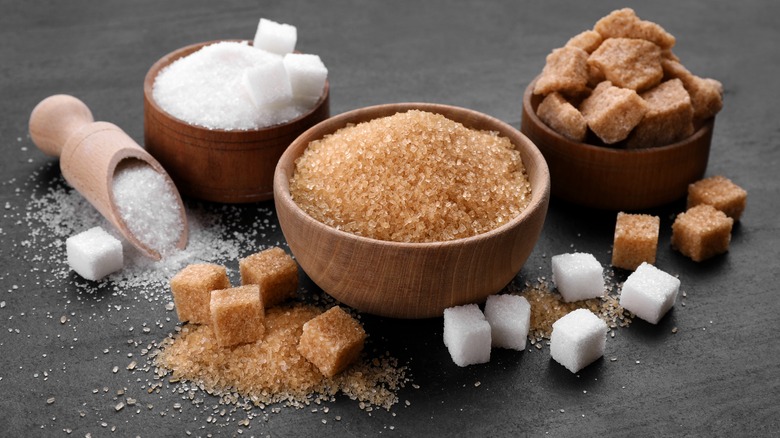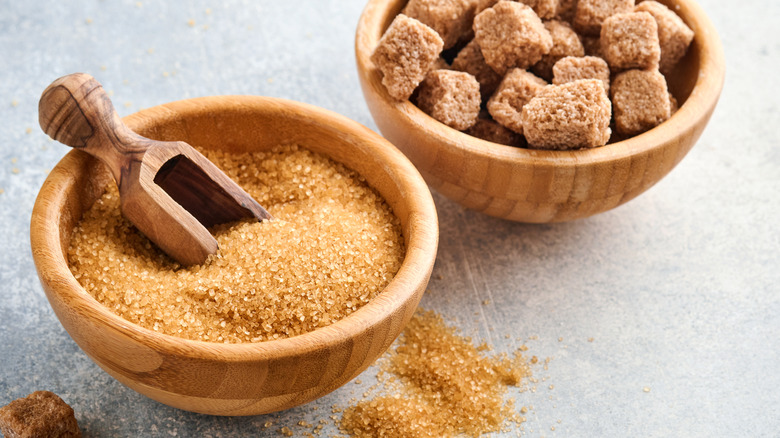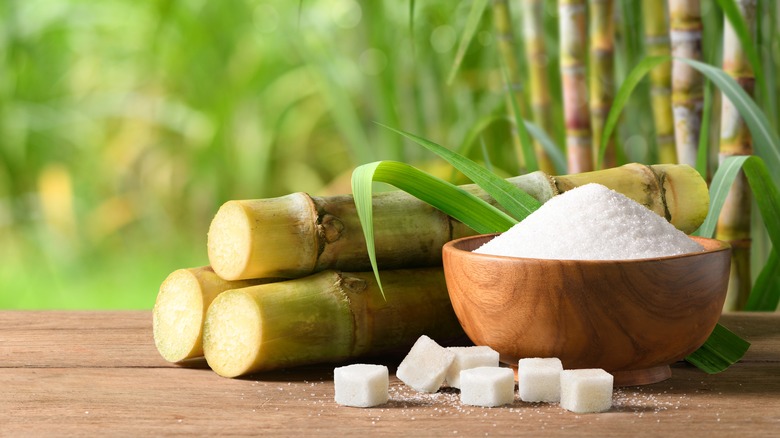The Important Difference Between Cane And Granulated Sugars
As far back as 8000 B.C., the people of New Guinea chewed on the stalks of the indigenous sugar cane plant, savoring its sweet, juicy flavor. In 510 B.C., when Darius I invaded India, he was captivated by "the reed which gives honey without bees." Then, in the 11th century, Western Crusaders returned home from the Holy Wars, bringing with them this "sweet salt." This substance is what we now think of as granulated sugar, notable for its pure white color and simple flavor.
Close to but distinct from granulated sugar is an amorphous category labeled "cane sugar" in stores. For our purposes here, cane sugar is light beige in color and features slightly larger crystals.
Technically, all sugar derived from sugar cane is, logically, cane sugar. However, consumer classifications and labeling can be confusing. To understand the differences, it's important to know what the three types of sugar are: unrefined, raw, and refined. All sugars are processed and refined to some degree, which affects the size of the crystals and the amount of molasses — a byproduct of sugar refining — that remains in the final product. While the difference between granulated and cane sugar is subtle, it's essential when considering the flavor and texture you want.
Cane sugars offer a crunchy, caramel-like profile
Packaged cane sugars include specific types like turbinado and demerara, as well as the branded "Sugar in the Raw." As the term "raw" suggests, these are, in fact, raw sugars, falling between refined white sugar, with its bleached tone and basic sweetness, and unrefined, molasses-heavy varieties like muscovado, jaggery, and piloncillo. Cane sugar crystals can range from just slightly larger than those of white sugar to noticeably chunky, with a hint of caramel-like flavor.
While the smaller-grained types of cane sugar are essentially interchangeable with white sugar in recipes, you should think twice about using the larger crystals because they dissolve more slowly in liquids. For instance, in a hot drink — like a creamy pumpkin spice latte — they take much longer to break down, and in a cold drink, you're likely to end up with a sugary layer at the bottom of your glass.
Cane sugar shines as a dessert topping, adding a light crunch and a subtle molasses note. It's commonly used on muffins and pies — such as in this cinnamon roll pie with apples — though some people do also incorporate it into cookies and cakes.
White sugar has a neutral, clean sweetness
Historically, refined sugar, with its delicate consistency and bright, clean appearance, became a symbol of refinement and wealth, affordable only to the upper echelons of society. By the 1700s, sugar beets were being refined into white sugar, making the sweetener cheaper and more accessible. The lack of molasses — whether in cane or beet sugar — results in a neutral sweetness, while the tiny crystals dissolve quickly and easily. These qualities make it suitable for nearly any application, from baking to beverages, salad dressings to sauces. Additionally, the lack of color compared to raw and unrefined sugars ensures it won't alter the appearance of the final product. While you can swap in cane sugar for granulated sugar, consider how differences in color, consistency, and flavor might affect your recipe.
In the United States, the government doesn't require labeling to specify whether your sugar is derived from cane or beets. For this reason, vegans and vegetarians need to do their research to avoid refined cane sugars, which are processed with animal-based bone char to achieve their white hue. Even generic brown sugar, commonly used in baking, typically begins as white sugar, with molasses added back in. Beet sugar, however, is processed without any animal products and is indistinguishable in flavor, making it an easy swap.



